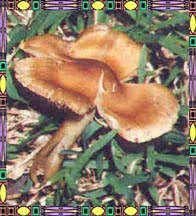Sunday, 18 November 2012
Inocybe aeruginascens
Cap: 1-5 cm broad. Conic at first and expanding with age to convex and plane with an obtuse umbo. Margin incurved in young. The color is osrdid buff ot ochraceous brown with greenish tinges.
Gills:Adnate to nearly free, crowded, pale grayish brown to clay brown with greenish tones and bruising blue where injured.
Stem:22-50 mm long by 3-7 mm thick, equal with some swelling at the base. Solid, whitish to pallid becoming bluish green from the base upwards. Pruinose near the apex and fibrillose below. partial veil corinate and disappearing. Bruising blue where damaged.
Spores:7.5-10 x 4-5 microns.
Sporeprint:Clay brown in deposit, smooth, ellipsoid and inequilateral.
Habitat:In sandy soils (including dunes) underneath Populus (poplars) and Salix (willows)
Distribution:Widely distributed across the temperate regions of the world. Reported from central Europe and western North America.
Season:June through October.
Dosage:1-2 grams dried.
Comment:Contains psilocybine, baeocystine and a newly discovered Indole by Gartz which he named aeruginascine. Was the cause of several unintentioanal intoxication in Europe in the 1980s and was reported as being very euphoric in its actions and effects.
Subscribe to:
Post Comments (Atom)


No comments:
Post a Comment